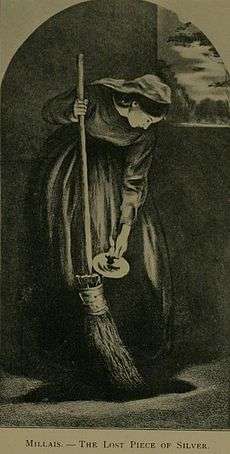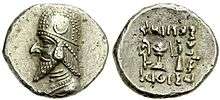Parable of the Lost Coin

The Parable of the Lost Coin is one of the parables of Jesus. It appears in Luke 15:8–10. In it, a woman searches for a lost coin, finds it, and rejoices. It is a member of a trilogy on redemption that Jesus tells after the Pharisees and religious leaders accuse him of welcoming and eating with "sinners."[1] The other two are the Parable of the Lost Sheep, and the Parable of the Lost Son or Prodigal Son.
Narrative

As recounted in Luke 15, a woman with ten silver coins (Greek drachmae) loses one. She then lights an oil lamp and sweeps her house until she finds it, rejoicing when she does:
Or what woman, if she had ten drachma coins, if she lost one drachma coin, wouldn't light a lamp, sweep the house, and seek diligently until she found it? When she has found it, she calls together her friends and neighbors, saying, 'Rejoice with me, for I have found the drachma which I had lost.' Even so, I tell you, there is joy in the presence of the angels of God over one sinner repenting."
— Luke 15:8–10, World English Bible

Interpretation
119 Ministries explains in the teaching "The Missing Silver Coin" [2] The coins represent the 10 commandments which summed up the 613 commandments in Torah. Then one of the commandments (keeping the Sabbath) was lost. And when found (or rather discovered) this commandment was proclaimed to be for ever, one would repent and rejoice in being able to further glorify God.
This interpretation seems highly unlikely as it relates, in final verse of this parable (Luke 15:10), to "one sinner who repents." As with the parables immediately prior and following, the lost sheep and the lost son respectively, this is a parable dealing with lost people, not lost commandments.
Joel B. Green notes that the woman described is a poor peasant, and the ten silver coins, corresponding to ten days wages, "likely represent the family savings."[3] The coins may also have been the woman's dowry, worn as an ornament.[4][5] Both theories may be true, and either one explains the urgency of the woman's search, and the extent of her joy when the missing coin is found.
Like the Parable of the Ten Virgins, this is a parable about women which immediately follows, and makes the same point as, a preceding parable about men.[6] In Greek, the "friends and neighbors" are female.[7]
Green suggests that the invitation to the "friends and neighbors" may reflect a celebratory meal, which recalls the meals Jesus is accused of sharing with "sinners."[3] The woman's diligent activity in searching may symbolise either Jesus' own activity or that of God the Father.[4] The rejoicing of the angels is understood to be rejoicing along with God.[5]
Depictions
This parable has been depicted by several artists, including John Everett Millais, Jan Luyken, Domenico Fetti, and James Tissot.
| Wikimedia Commons has media related to Parable of the Lost Coin. |
See also
References
- ↑ Richard N. Longenecker, The Challenge of Jesus' Parables, Eerdmans, 2000, ISBN 0-8028-4638-6, p. 201.
- ↑ 119 Ministries, The Missing Coin
- 1 2 Joel B. Green, The Gospel of Luke, Eerdmans, 1997, ISBN 0-8028-2315-7, p. 576.
- 1 2 Ben Witherington, Women in the Ministry of Jesus: A study of Jesus' attitudes to women and their roles as reflected in his earthly life, Cambridge University Press, 1987, ISBN 0-521-34781-5, p. 39.
- 1 2 I. Howard Marshall, The Gospel of Luke: A commentary on the Greek text, Eerdmans, 1978, ISBN 0-8028-3512-0, p. 603.
- ↑ The Parable of the Ten Virgins follows the Parable of the Faithful Servant, and this parable follows the Parable of the Lost Sheep.
- ↑ Mary Ann Beavis, The Lost Coin: Parables of women, work, and wisdom, Continuum, 2002, ISBN 1-84127-313-9, p. 36.